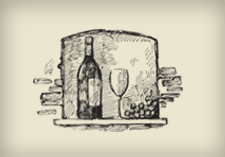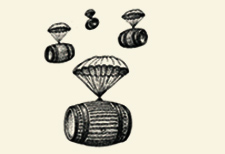Current News
Mel announces his retirement!
Barrel Maintenance
Futsing around with barrels: or how to stave off VA.
As a barrel broker, I am oftentimes asked questions about what to do with barrels. My usual answer is 'I don't care as long as your check is good' or "If I tell you and something goes wrong, will you blame me?' Sometimes I suggest putting wine in them, but that's usually about as far as I go.
Finally, I decided to talk to two winemakers with a great deal of experience in barrel management, Russ Rosner, then of Robert Mondavi and now the winemaker for Sokol Blosser in Oregon, and Dave Ramey then of Matanzas Creek. Here are their unexpurgated opinions:
Interview with David Ramey
Dave Ramey, the winemaker at Matanzas Creek, worked as the assistant winemaker at Simi for five years before taking the head job at Matanzas Creek in the fall of 1984. Dave has a Master's degree in Oenology and Viticulture from UC Davis and worked for the Moueix group in Pomerol/St Emilion and here before going to work for Simi. Now he makes wine under his own label.
MCK: What do you do with new barrels before filling them with wine?
DR: Traditionally I filled them with hot (160 degrees F) water for 12 hours. I say 160 degrees average because the temperature varies between 140 and 180 degrees. Now I am doing trials with 12 hours of hot water, 12 hours of cold water, and no treatment at all. I think we will go to either an overnight cold-water fill or to a short hot water rinse. We use a high percentage of new barrels here and I find 'no treatment' to give coarser wines.
Hot water extracts color, extract, and tannin. Also, there is the question of energy efficiency. It may be that the hot water is opening up the wood. Toast is being pulled out. Therefore the wine may be more tannic.
MCK: What about leakers?
DR: With barrel fermentation I find that soaking is not necessary because the juice is like glue.
MCK: When do you empty the barrels?
DR: Chardonnay comes out of the barrel in May. The barrel is then rinsed. We notice that with lees stirring there is less tartrate formation. We now do a hot water rinse with 80 pounds of pressure at around 180 degrees. If tartrates are left, they will dry out. Perhaps with greater lees stirring only cold water will be necessary. We then drain the barrels 1-2 hours and then roll them up. This is an advantage of barrel pallets. We then give them 2 seconds of SO2 gas. Thirty minutes later we roll the barrels back so the bunghole is down and then put the barrels into a cool place. We re-sulfur and re inspect the barrels every six weeks.
MCK: Dave, you have a humidified, temperature controlled barrel room? What would you do if you had your barrels in a warm, dry room?
DR: We have too big of an investment not to have temperature and humidity control. A winery with 300 barrels has $120,000 (a little more now!) in barrels alone, not to mention the contents. Temperature affects the integrity of barrels and low temperature inhibits microbial growth. A bunged up barrel creates a humid atmosphere that promotes microbial growth, especially at high temperature.
When you have temperature and humidity control a winery can reduce evaporation loss and promote slower and steadier development of the wine, get fresher white wines especially, not to mention what you do for barrel integrity.
MCK: What do you do when you go to re-use these barrels
DR: Traditionally we soaked them up the night before with hot water, but we may be switching to 12 hours soak with cold water, or a hot water rinse, or to no treatment at all. Because there is no SO2 in the barrels, the soaking is not as important as before.
MCK: What would you do if you had a problem with VA in a barrel?
DR: A one-day soak with hot water usually does the trick.
MCK: I wonder if you could discuss the barrel management techniques you recently observed in France?
DR: Well, the traditional technique in Bordeaux is to rinse, drain, SO2, then re-sulfur eight days later. The barrels are bunged up when they are dry, usually 2-3 weeks later.
MCK: What about the people who are leaving wine in the barrels?
DR: At several wineries people rinse the barrels with water or wine to clean out the lees, then they leave the empty barrel with wine and SO2. At Olivier Leflaive's they sulfur empty but not rinsed barrels. They leave the barrels open and then in two weeks they re-sulfur and bung up. Then they re-sulfur every six weeks. Water never touches the barrels. If low pH inhibits microbial growth, then water pushes the pH up to 6 or 7 and creates conditions of microbial growth.
MCK: Of course, their cellars are usually cooler and more humid than ours.We then went down into the barrel room and smelled some empty barrels:
Barrel 1: 16 days after emptying: Very sweet.
Barrel 2: Dave commented that this barrel was a worst-case situation. He had forgotten about this barrel for one year. It had developed a VA problem, which he had treated with soda ash and hot water. It has been empty 2 months and has a faint odor of VA.
Barrel 3: Empty of merlot for five weeks, smelled nice.
Barrel 4: Barrel fermented chardonnay. Empty two months--smells great, let's have a glass!
Interview with Russ Rosner
Russ Rosner, production enologist at Robert Mondavi, joined RM in 1983 after previous stints with Felton Empire and Rombauer. He has been in charge of their barrel program for several years
MCK: What do you do with new barrels?
RR: For the Mondavi wines we fill them with cold water for one day, then they are inspected for leaks. The heads are treated with mildewcide to prevent end-grain leaks. Information cards are stapled onto the heads. The barrels are emptied and sulfured, then later filled. For the Joint Venture Project the barrels are filled with 5 liters of freshly boiled water, bunged, and agitated. The cooling water pulls a vacuum and draws the staves tight.
Seguin-Moreau has done studies of extraction curves with various forms of treatments: cold soak, warm water, steam, hot water, etc.
We are doing trials right now for the Joint Venture Project along these lines. 60% of the barrels were prepared in '86 with 4 gallons of hot water, agitation, and inspection. We stand the barrels on both heads.
MCK: Does the hot water remove the toast?
RR: Surface char may be removed but if toast is done slowly, it will be retained. Hot water does not appear to tone down the oakiness.Cold-water treatment calls for space, but is not labor intensive. Using hot or boiling water is the opposite. It's quicker if you just throw people at it. It's better if you need barrels quickly.
The important question is which is better for the wine, but if there is no difference then it's just a question of logistics and economics.
New barrels are sulfured and stored open. This year we will try not treating the heads with mildewcide.
MCK: You have humidity and temperature control in your barrel storage facilities. How does this help you? RR: First, at 60% humidity and above, alcohol evaporates whereas at below 60% humidity water evaporates. So this helps give us lower alcohol levels, although this is primarily done by picking at the right sugars. Also, we don't have to tighten hoops, which saves us a lot of important time. Because we store our barrels open, without sulfur, we don't have to re-soak the barrel; just rinse it. Our barrels are stored at 90% humidity.
MCK: What do you do when you empty barrels?
RR: First, we empty the barrel. Then it is rinsed with cold water, unless it is caked with lees. In that case we use a pressure-washer. After being drained for fifteen minutes, the barrel is gassed when upright for 2 seconds. A paper cup closure keeps the SO2 in the barrel. We are testing a SO2 vaporizer that heats the gas. This may give us a more even flow and better dispersion.
The barrels are shipped back to the warehouse and the closure is taken out. The barrels are rolled to 6 o'clock for more draining and are left open for a month. The SO2 usually goes away after two or three days
MCK: Have you always done it this way?
RR: It used to be that we bunged up the barrel with either a quarter stick of sulfur or 2 seconds of gas every six weeks. Oftentimes the barrel was also rinsed and oftentimes we had high VA problems. I like to think that there are two kinds of VA --microbial and chemical. We had a high incidence of microbial VA. Chemical VA can be produced when the SO2 reacts with esters in the wood. You can get acetate formation.
With our new techniques we get almost nil VA. Occasionally we get mold--perhaps because the barrel was missed or not enough gas was used. One thing to remember is that the pressure in the SO2 dispenser can vary.
This system is not for everybody. You cannot do just part of it. You have to do it all, particularly temperature and humidity control.
We can only wash barrels so fast so sometimes the barrels back up. Perhaps barrels store better dirty than clean. Is it the alcohol? The pH? We are doing experiment comparing open vs. closed, clean vs. dirty, etc.
MCK: What exactly are you doing now?
RR: Every four weeks we re-sulfur. The barrel is first left open with the bunghole at six o'clock for the first four weeks. Then we put the bunghole at 4 o'clock. Right now we are working on extending the SO2 interval. Drying time has been reduced. After all, how long does it take to dry a barrel? Really, only a few days. Moisture inside the barrel is the enemy. We are now going to two months between sulfuring. The barrels are sulfured and cupped at then end of the day. The cups are pulled and the workers flee. Later the barrels are rolled to PSRA--Production Scale Resulfuring Angle (4 o'clock).
It used to be that the barrels were stored in rows, with bilges touching because there were so many empty barrels. Nowadays there are fewer empty barrels so a guy on a scissor lift can do the resulfuring in place. Formerly the stacks had to be taken down, put outside, etc.
MCK: What do you do before re-filling?
RR: All barrels are washed before filling. We have a barrel washer that looks like a ride out of Disneyland. The barrels get 3-4 minutes of 180 degree water with soda ash. Then they get a cold-water rinse and a minute or two of citric, followed by a cold-water rinse. I would like to eliminate the use of chemicals, as I think that hot water may be enough.
Further comments: Russ pointed out that not only did the open barrel program yield fewer VA problems, but that it was also easier on the health of the staff. His predecessor, Charles Thomas, had his brain eaten away by too much SO2 and now is only allowed to work with computers. Russ asked me to emphasize that there is a difference between what Mondavi is doing now and what practices they may be considering.

